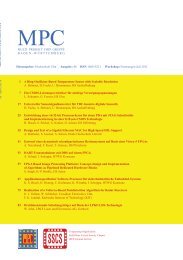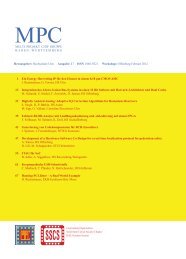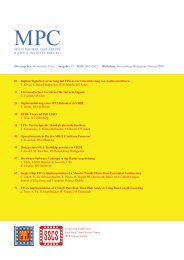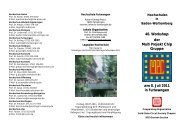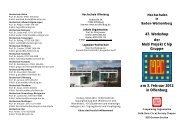Workshopband als PDF - Mpc.belwue.de
Workshopband als PDF - Mpc.belwue.de
Workshopband als PDF - Mpc.belwue.de
Erfolgreiche ePaper selbst erstellen
Machen Sie aus Ihren PDF Publikationen ein blätterbares Flipbook mit unserer einzigartigen Google optimierten e-Paper Software.
Table 1: : Comparison of the performance of the converter, with and<br />
without the fast transient techniques<br />
Boost<br />
Buck<br />
Buck-<br />
Boost<br />
100mA – 500mA<br />
∆Vout in mV Respon-<br />
FT<br />
no FT<br />
FT<br />
no FT<br />
FT<br />
no FT<br />
200<br />
240<br />
120<br />
200<br />
180<br />
200<br />
se time<br />
54 µs<br />
131 µs<br />
94 µs<br />
185 µs<br />
56 µs<br />
155 µs<br />
300 mV. Fig. 10 and Fig. 11 show the simulation<br />
results at a load transient from 100 mA to 500 mA and<br />
vice versa in boost and buck mo<strong>de</strong>, respectively respectively. Table<br />
1 shows the comparison of the performances with and<br />
without the new fast techniques in the current mo<strong>de</strong><br />
buck-boost DC-DC converter. In boost mo<strong>de</strong>, the<br />
improvements, in the voltage un<strong>de</strong>rshoot and the rre<br />
sponse time from light-to-heavy heavy load, are 16.7 % and<br />
58.8 %, respectively. In buck mo<strong>de</strong> the improvements<br />
are 40 % and 49.2 % and in buck-boost boost mo<strong>de</strong> mo<strong>de</strong>, 10 %<br />
and 63.9 %, respectively. . The improvements in the<br />
voltage overshoot and the response time from heavy-<br />
to-light light load are, in boost mo<strong>de</strong>, 51.9 % and 56.9 %, in<br />
buck mo<strong>de</strong>, 13.6 % and 68.5 % and in buck buck-boost<br />
mo<strong>de</strong>, 40 % and 48.1 %, respectively. The efficiency<br />
of the converter is at 60 % at light load (10 mA) and<br />
91 to 95 % at heavy load (50-900 mA) mA). At light load,<br />
the efficiency suffers from the switching losses of the<br />
power switches MA to MD. . Obviously, the proposed<br />
fast transient mechanism shows better rresults.<br />
V. CONCLUSIONS IONS<br />
A fast transient current mo<strong>de</strong> buck buck-boost DC-DC<br />
converter with a good power management and a good<br />
transient performance is presented to realize a stable<br />
supply voltage for portable <strong>de</strong>vices. The critical points<br />
in a buck-boost boost converter are the stability and a co constant<br />
output voltage. Therefore, the adap adaptive pulse<br />
skipping APS and the adaptive compensation capac capacitance<br />
ACC are proposed as a new fast transient mec mechanism.<br />
Not only the transient response is improved,<br />
but <strong>als</strong>o the overshoot/un<strong>de</strong>rshoot voltage of Vout.<br />
Further, the system stability can be ensur ensured by the<br />
ACC, due to its adjustable value. Simulation results<br />
<strong>de</strong>monstrated the potential of the fast transient tec techniques.<br />
With the presented fast transient current mo<strong>de</strong><br />
buck-boost DC-DC DC converter, a solution for an eff efficient<br />
power management was found. This way, it is<br />
possible to lower the risk of <strong>de</strong>teriorations, e.g. uun-<br />
wanted resets, to the powered micro-controller<br />
(µC).<br />
REFERENCES<br />
500mA –100mA<br />
∆Vout in mV Respon-<br />
130<br />
se time<br />
59 µs<br />
270<br />
190<br />
220<br />
150<br />
250<br />
137 µs<br />
41 µs<br />
130 µs<br />
69 µs<br />
133 µs<br />
[1] Y.-H Lee, S.-C. Huang, S-W. W. Wang, W. W.-C. Wu and K.-H.<br />
Chen , “Power-tracking tracking embed<strong>de</strong>d buck buck-boost converter with<br />
fast dynamic voltage scaling for the SoC system,” IEEE<br />
Trans. Power Electronics, pp. 1271–1282, 1282, March 2012.<br />
22<br />
A CURRENT-MODE BUCK-BOOST DC-DC CONVERTER<br />
WITH FAST TRANSIENT RESPONSE<br />
[2] C.-L. Wei, C.-H. Chen, K.-C. C. Wu; I. I.-T. Ko; , "Design of an<br />
average-current-mo<strong>de</strong> mo<strong>de</strong> noninverting buck buck–boost dc–dc converter<br />
with reduced switching and conduction lo losses," IEEE<br />
Trans. Power Electronics, , pp.4934 pp.4934-4943, Dec. 2012.<br />
[3] B. Sahu, and G.A.R. Mora,, "A low voltage, dynamic,<br />
noninverting, synchronous buck buck-boost converter for portable<br />
applications," IEEE Transactions on Power Electronics Electronics,<br />
vol.19, no.2, pp. 443- 452, , March 2004.<br />
[4] B. Sahu, and G.A.R. Mora, “A high high-efficiency dual-mo<strong>de</strong>,<br />
dynamic, buck-boost boost power supply IC for portable applic applications,”<br />
VLSI <strong>de</strong>sign, , 2005, pp.858 pp.858–861.<br />
[5] Y.-H Lee, S.-C. Huang, S-W. W. Wang and K. K.-H. Chen, “Fast<br />
transient (FT) technique with adapti adaptive phase margin (APM)<br />
for current mo<strong>de</strong> dc-dc dc buck converter” IEEE Trans. On<br />
Very Large Scale Integration (VLSI) Systems Systems, vol. 20, no. 10,<br />
pp. 1781-1793, Oct. 2012.<br />
[6] C.-Y. Hsieh and K.-H. H. Chen, “Adaptive Pole Pole-Zero Position<br />
(APZP) Technique of Regulated Power Supply for Improving<br />
SNR”, IEEE Trans. On Power Electronics Electronics, vol. 23, no. 6,<br />
pp. 2949-2963, 2008.<br />
[7] J.-C. Tsai, C.-L. Chen, Y.-H. H. Lee, H. H.-Y. Yang, M-S.Hsu,<br />
and K.-H. H. Chen, „modified hysteretic current control<br />
(MHCC) for improving transient response of boost convert-<br />
er”, IEEE Trans. On Circuit And nd Systems Systems, vol.58, no.8, Aug.<br />
2011.<br />
[8] K.-H. Chen, C.-J. J. Chang and T. T.-H. Liu, “Bidirectional cur-<br />
rent-mo<strong>de</strong> mo<strong>de</strong> capacitor multipliers for on on-chip compensation”,<br />
IEEE Trans. On Power Electron ectron., vol.23, no.1, pp. 180-188,<br />
Jan. 2008.<br />
Andreas Ehrhart received the B.Eng. Degree in<br />
Electronics, Vehicle Electronics and<br />
Meachtronic Systems Systems, in 2010 from the Ba<strong>de</strong>n-<br />
Württemberg Cooperative State University<br />
(DHBW) Ravensburg and the M.Sc. Degree in<br />
Electronics, Power Power- and Micro Electronics, in<br />
2012 from the Reutlingen University.<br />
Bernhard Wicht received the Dipl. Dipl.-Ing. Degree<br />
from the Technical University Dres<strong>de</strong>n in 1996<br />
and the Ph.D. <strong>de</strong>gree from the Technical Un University<br />
Munich in 2002. 2003 - 2010, he was<br />
with the Mixed Signal Automoti Automotive business<br />
unit of Texas Instruments, in Freising, Germ Germany,<br />
responsible for the <strong>de</strong>velopment of autom automotive<br />
smart power ICs. Since September 2010 he<br />
is professor for integrated circuits at Reutlingen<br />
University, Robert Bosch Center for Power<br />
Electronics.<br />
Ke-Horng Horng Chen received the B.Sc., M.Sc. and<br />
the Ph.D <strong>de</strong>grees in electrical engineering from<br />
the National Taiwan University, Taipei, Ta Taiwan,<br />
R.O.C., in 1994, 1996, and 2003, respe respectively.<br />
From 1996 to 1998, he was a part part-time<br />
IC Designer at Philips, Taipei Taipei. From 1998 to<br />
2000, he was an Application Engineer at<br />
Avanti, Ltd., Taiwan. wan. From 2000 to 2003, he<br />
was Project Manager at ACARD, Ltd., where<br />
he was involved in <strong>de</strong>signing power manag management<br />
ICs. He is currently an Associate Profe Professor<br />
in the Department of Elec Electrical Engineering,<br />
National Chiao Tung University, Hsinchu,<br />
Taiwan, where he organized a Mixed Mixed-Signal<br />
and Power Management IC Laboratory.



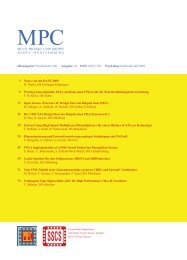
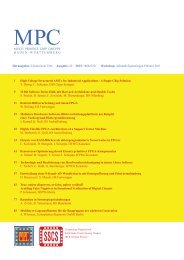
![[Geben Sie hier die Überschrift ein] - MPC](https://img.yumpu.com/8654082/1/188x260/geben-sie-hier-die-uberschrift-ein-mpc.jpg?quality=85)
